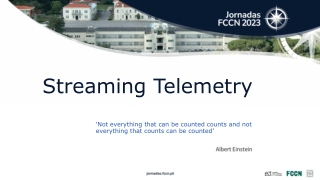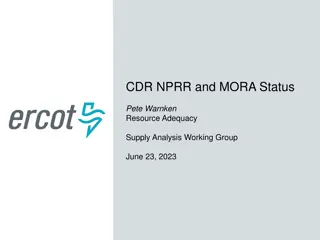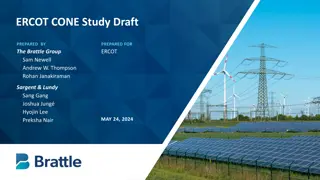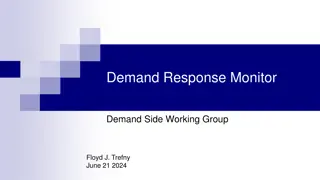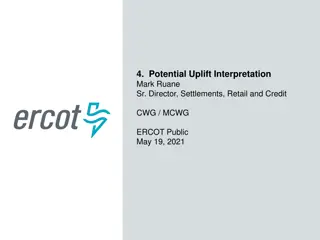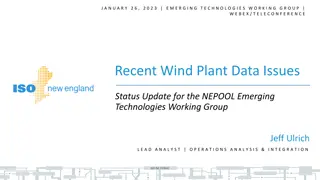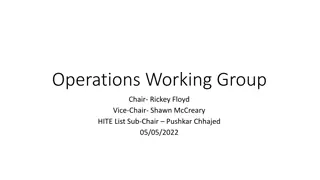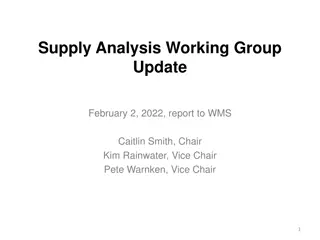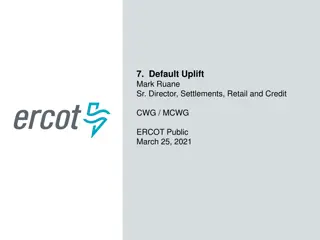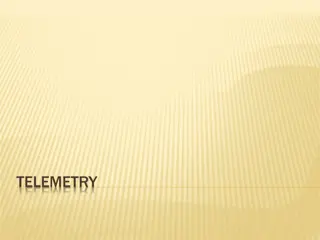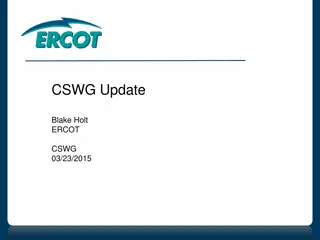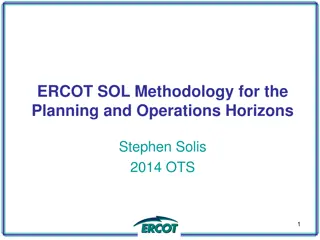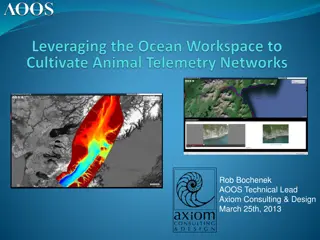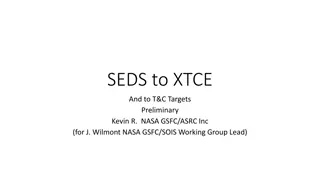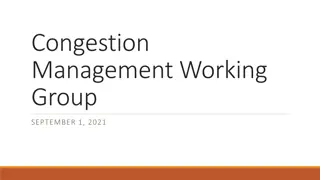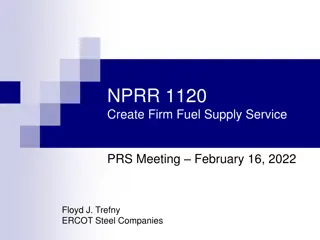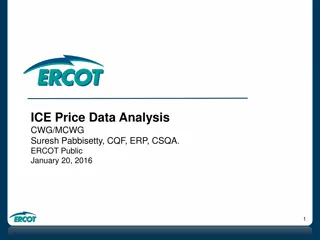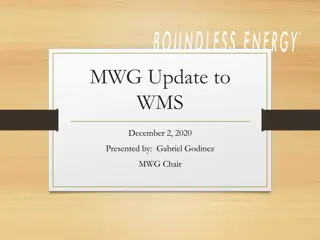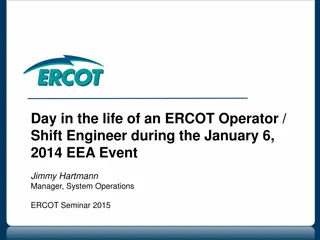Enhancing Generator Telemetry Transparency for ERCOT
This document discusses telemetry issues, recommendations for generator systems, and a proposed solution (NPRR 1085) to improve ERCOT's system health transparency. It highlights the need for better communication of uncertainty in telemetry, clarity in updating telemetry, and mechanisms to align generator solutions with reserve calculations. The goal is to ensure accurate reserve estimations and prevent overestimation due to telemetry errors.
Download Presentation

Please find below an Image/Link to download the presentation.
The content on the website is provided AS IS for your information and personal use only. It may not be sold, licensed, or shared on other websites without obtaining consent from the author.If you encounter any issues during the download, it is possible that the publisher has removed the file from their server.
You are allowed to download the files provided on this website for personal or commercial use, subject to the condition that they are used lawfully. All files are the property of their respective owners.
The content on the website is provided AS IS for your information and personal use only. It may not be sold, licensed, or shared on other websites without obtaining consent from the author.
E N D
Presentation Transcript
Emergency items list: Telemetry July 15th, 2021 Lori.Simpson@constellation.com (an Exelon company) Jimmy Jackson, CPS Energy
Telemetry issues recommendations Generator telemetry transparency: What is the problem with telemetry Requirements for generators to solve Ensure ERCOT systems use solution ERCOT check Alternative system health metrics: HDL Additional transparency recommendations: 30-minute integrated ramp telemetry
Generator telemetry transparency: What is the problem with telemetry Requirements for generators to solve Ensure ERCOT systems use solution ERCOT check
The problem with generator telemetry ERCOT presented at PDCWG that generators had telemetry errors on 2/15 that led to overestimation of reserves. See blue area in slide
Solution for generators (1085) ERCOT proposal: NPRR 1085 Goal is to improve ERCOT s transparency into the health of the system. Requires updated telemetry within 5 minutes of an issue at a plant. What is missing from this NPRR Updating telemetry is too vague and does not allow generators to convey uncertainty. There is not specific instruction for what generators should change telemetry to. What is needed in a solution: Conveyance of uncertainty Simplicity of solution that does distract the generator operators from their primary mission of fixing the problem in the safest manner possible. What is the solution: A status that a generator can quickly switch to that would trigger the headroom to be excluded from reserve calculations and the basepoint to be locked to the output: ONTEST, ONHOLD, EMR, raise block flag, programmatically set HSL/LSL close to output, etc.
Ensure gen solution aligns with reserve calculations Ensure that ERCOT systems calculations exclude headroom or separately call out headroom when calculating reserves, HDL, etc for resources using the desired solution (ONTEST, ONHOLD, EMR, raise block flag, etc.). If not, then modify calculations. ERCOT should evaluate whether or not these statuses should trigger PRC and reserve calculations to exclude the headroom: ONTEST ONHOLD EMR Raise Block flag
ERCOT should build a check ERCOT should have a mechanism to track if resources are having undisclosed issues and not using the desired mechanism (ONTEST, ONHOLD, raise block flag, etc.). For example, this check could flag resources that have not been able to achieve their basepoints over x SCED intervals. This could trigger ERCOT to throw out the unit s headroom in reserves calculations or request that the unit initiate the desired solution (ONTEST, ONHOLD, EMR, raise block flag, etc.).
System health gauges: alternative to PRC & frequency Reserve calculation PRC and frequency are two mechanisms for gauging real-time health of the system. ERCOT should consider using additional mechanisms/triggers to measure the system health that is used to trigger controlled load shed. One possibility is using the HDL so as to incorporate the ramp restrictions. Price ORDC reserves HDL-GTBD Frequency
Additional transparency recommendations: 30-minute integrated ramp telemetry
30-minute integrated ramp telemetry The current instantaneous ramp rategives ERCOT an indication of capability in the next 5 minutes (HDL). There is limited visibility into integrated ramp rate for the next 30 minutes. This is part of RTC, but potentially this implementation needs to be moved forward. It would be helpful to look at what other markets are doing in this area: when there are severe system issues in PJM, the ISO asks the Market Participants to supply information in either an Instantaneous Reserve Check (IRS) or Supplemental Status Report (SSR) to ensure the reserves the ISO thinks they have is confirmed to validate telemetry. (edart- training-irc-and-mingen.ashx (pjm.com)).
Other items for discussion PBP Congestion at the cap
PBP PBP Power balance penalty is used instead of dispatching real generation (it looks like a generator in SCED). (This happened on 2/15 at 1:45am when HDL was 3mw and system lambda was $7,500). The diff possibly has to be made up by up-reg. This could lead to undergeneration as the GTBD only uses 20% of deployed regulation. Should the PBP simply be at the cap?
De De minimus minimus congestion near the cap congestion near the cap We observed how very small shift factors on constraints can cause bus prices to be slightly below the cap (when system lambda is at the cap). When those resources are offered at the cap, SCED has no effective way of dispatching that generator despite it having a de minimus impact on a constraint. EOCs at the cap 2/15 Bus prices under the cap 2/15 BA SE_ POI NT SCED1_ CURVE_ MW1 SCED1_ CURVE_ PRICE1 SCED1_ CURVE_ MW2 SCED1_ CURVE_ PRICE2 SCED1_ CURVE_ MW3 SCED1_ CURVE_ PRICE3 SCED1_ CURVE_ MW4 SCED1_ CURVE_ PRICE4 SCED1_ CURVE_ MW5 SCED1_ CURVE_ PRICE5 System_ lambda Hb_north ESR 1 ESR 2 RESOUR CE_TYPE LMPsc PWRSTR- - (250) 1 9,000 30 9,000 2/15/21 1:00 2/15/21 1:05 2/15/21 1:10 2/15/21 1:15 2/15/21 1:20 2/15/21 1:25 2/15/21 1:30 2/15/21 1:35 2/15/21 1:40 9,001 9,001 9,001 9,001 9,001 9,001 4,500 3,249 4,358 7,500 6,061 8,657 8,905 8,924 8,924 8,923 8,714 8,720 4,182 2,924 4,087 5,987 8,970 9,023 9,017 9,016 8,764 8,828 4,177 2,919 4,216 7,228 5,806 8,533 8,968 9,001 9,003 9,003 8,737 8,810 4,139 2,881 4,189 7,182 5,780 8,507 PWRSTR- - (250) 1 9,000 10 9,000 PWRSTR- - (250) - 9,000 33 9,000 PWRSTR- - (250) - 8,999 1 9,000 1 9,000 PWRSTR- - (250) 1 9,000 10 9,000 Does the fact that the offer cap matches the price cap make it effectively impossible to dispatch some generation offered at the cap? PWRSTR- - (250) - 9,000 PWRSTR- - (250) - 6,500 10 6,500 10 9,000 10 9,000 2/15/21 1:45 2/15/21 1:46 2/15/21 1:50 PWRSTR- - (250) - 8,999 10 9,000 10 9,000 8,407 PWRSTR- - (250) - 8,999 10 9,000 10 9,000 PWRSTR- - (250) - 8,999 10 9,000 10 9,000 PWRSTR- - (250) - 8,999 10 9,000 10 9,000 PWRSTR- - (250) - 8,999 10 9,000 10 9,000


